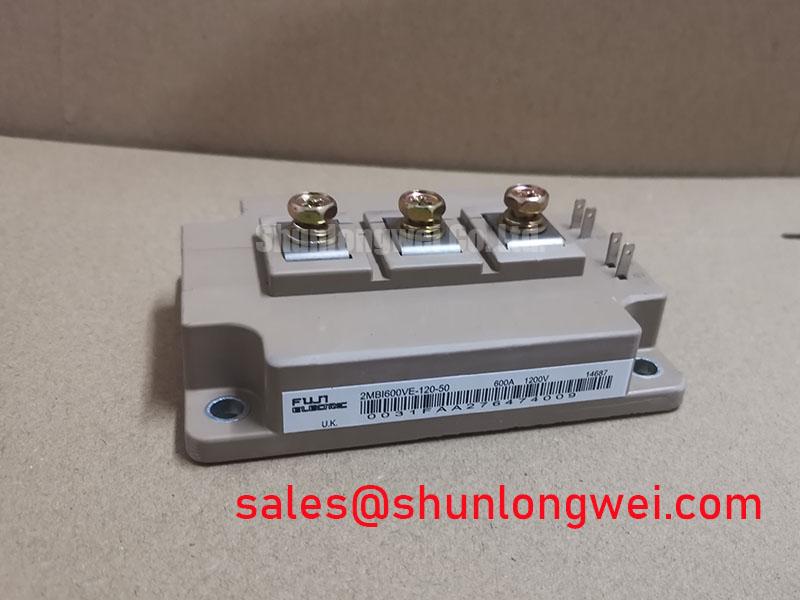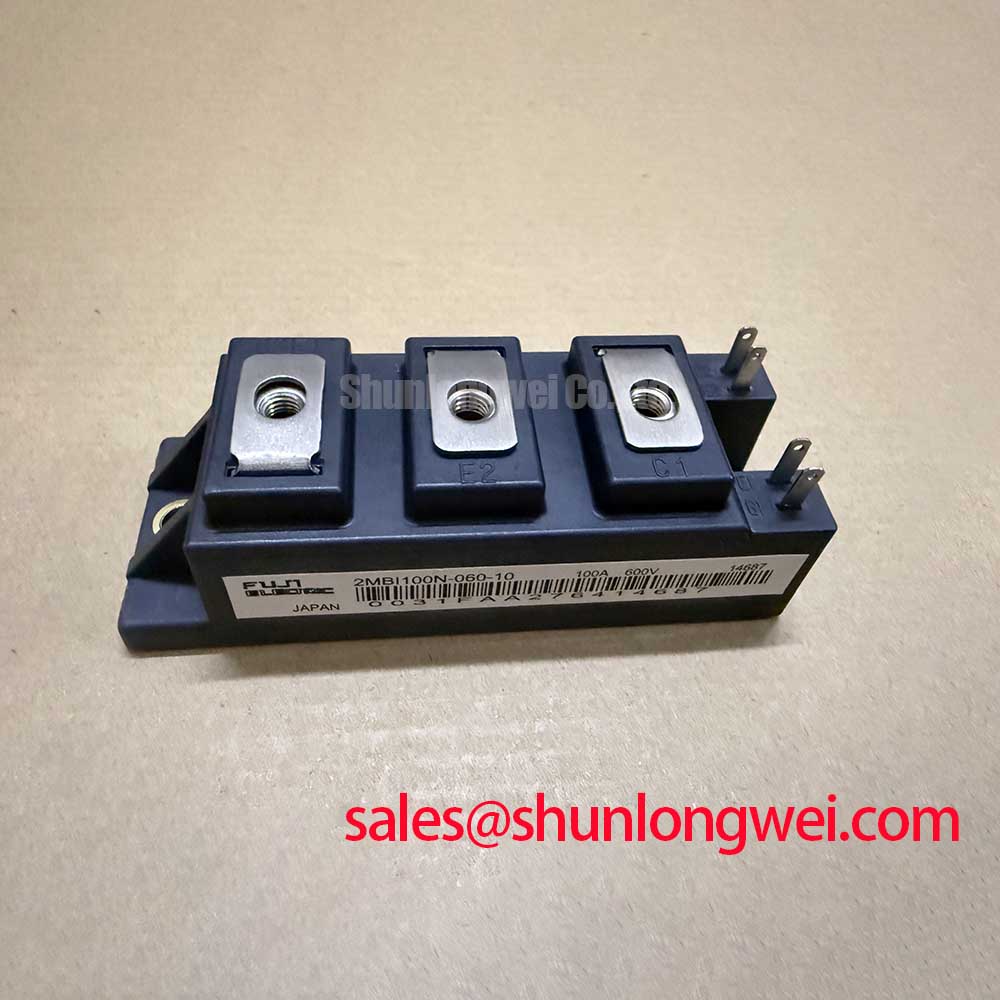Content last revised on November 20, 2025
7MBR35VP120-50 V-Series IGBT Module: Technical Analysis for High-Efficiency, Compact Motor Drives
An Engineering-Focused Review of the 7-in-1 Power Integrated Module (PIM)
The Fuji Electric 7MBR35VP120-50 is a highly integrated Power Integrated Module (PIM) that delivers exceptional power conversion efficiency and design simplicity for compact motor control systems. Leveraging Fuji's advanced V-Series IGBT technology, this module consolidates a complete three-phase inverter, converter, and brake chopper circuit into a single package. Key specifications include: 1200V | 35A | VCE(sat) of 1.95V (typ). This integration provides two primary engineering benefits: significantly lower thermal load and drastically reduced PCB real estate. The module directly addresses the engineering challenge of how to accelerate the design cycle for compact drives by providing a pre-optimized, all-in-one power stage. For low-to-mid-power variable frequency drives requiring high integration and efficiency, this 7-in-1 PIM is the optimal engineering choice.
Application Scenarios & Value
System-Level Benefits in Compact AC Motor Control
The 7MBR35VP120-50 is engineered for low-to-mid power applications where space, assembly cost, and energy efficiency are critical design constraints. Its most prominent application is in compact Variable Frequency Drives (VFDs) used to control AC induction motors in systems like industrial conveyors, HVAC fans, and water pumps. In a typical conveyor system, the integrated brake chopper is essential for dissipating regenerative energy during deceleration, ensuring controlled stops and enhancing system safety. The module's 35A current rating provides sufficient headroom for the inrush currents associated with motor startup under load. By combining seven semiconductor functions into one housing, it eliminates the need for multiple discrete components, simplifying the thermal management strategy and reducing manufacturing complexity. For systems that demand higher current handling for more powerful motors, the related 7MBR50VP120-50 offers a similar integrated topology with a 50A rating.
Key Parameter Overview
Decoding the Specs for Efficient Power Conversion
The electrical characteristics of the 7MBR35VP120-50 are optimized for performance and reliability in demanding industrial environments. The parameters below, drawn from the official datasheet, provide a foundation for system-level design and performance forecasting.
| Parameter | Symbol | Condition | Value |
|---|---|---|---|
| Collector-Emitter Voltage | VCES | Tj = 25°C | 1200V |
| Continuous Collector Current (Inverter) | IC | Tc = 80°C | 35A |
| Collector-Emitter Saturation Voltage (Inverter) | VCE(sat) | IC = 35A, VGE = 15V, Tj = 125°C | 1.95V (typ.) / 2.50V (max.) |
| Forward Voltage (FWD) | VF | IF = 35A, VGE = 0V, Tj = 125°C | 1.90V (typ.) / 2.45V (max.) |
| Thermal Resistance (Inverter IGBT) | Rth(j-c) | Junction to Case | 0.48 °C/W (max.) |
| Short-Circuit Withstand Time | tsc | VCC ≤ 800V, VGE ≤ 15V, Tj = 150°C | ≥ 10µs |
Download the 7MBR35VP120-50 datasheet for detailed specifications and performance curves.
The Collector-Emitter Saturation Voltage, VCE(sat), is a pivotal parameter for efficiency. A lower VCE(sat) directly reduces conduction losses. Think of it like the internal friction of a water pipe; a lower value means less energy is wasted as heat when current flows through the device, allowing for a smaller heatsink and a more compact overall system design.
Frequently Asked Questions (FAQ)
How does the 7-in-1 configuration of the 7MBR35VP120-50 benefit a compact VFD design?By integrating the input rectifier bridge, output inverter stage, and brake chopper into a single module, it drastically reduces the component count and simplifies the power stage layout. This leads to a smaller PCB, lower assembly costs, and reduced parasitic inductance compared to a design using discrete components, which can improve electrical performance and reliability.
What is the significance of the V-Series IGBT technology used in this module?The Fuji Electric V-Series represents an advanced generation of IGBT chip technology. It is specifically designed to achieve a superior trade-off between conduction losses (low VCE(sat)) and switching losses. This optimization results in higher overall inverter efficiency and reduced heat generation, which is a critical advantage in compact, often convection-cooled, drive systems.
How should the integrated NTC thermistor be utilized in a motor drive application?The built-in NTC thermistor provides a direct, real-time measurement of the module's substrate temperature. This data should be fed back to the system's microcontroller to implement over-temperature protection. It allows the controller to trigger alarms, reduce output power, or initiate a safe shutdown if the module approaches its maximum operating temperature, significantly enhancing the long-term reliability of the drive.
Is a negative gate voltage required for turning off the IGBTs in the 7MBR35VP120-50?While the datasheet specifies characteristics with a gate-emitter voltage of 0V for turn-off, applying a small negative voltage (e.g., -5V to -15V) is a common best practice in gate drive design. This provides a greater noise margin against unintended turn-on caused by dV/dt transients or Miller capacitance, which is particularly important in electrically noisy motor drive environments governed by standards like IEC 61800-3.
Strategic Design Implications
Accelerating Development of Energy-Efficient Power Systems
Selecting the 7MBR35VP120-50 is a strategic decision that extends beyond its electrical specifications. For engineering teams, it represents an opportunity to streamline the development process for power conversion hardware. The module's high level of integration acts as a validated subsystem, allowing designers to focus resources on higher-level tasks such as control software development and system integration. By abstracting the complexity of the power stage, it enables the creation of more reliable, compact, and energy-efficient products that can be brought to market faster. This makes it a key enabler for manufacturers competing in the industrial automation and appliance sectors where both performance and development agility are paramount.















